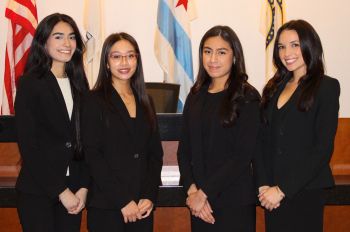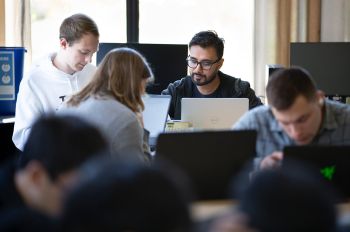History Through Their Eyes: Program Allows Students to Examine Race Riots of 1919

An assembly of high school students gathered at Illinois Institute of Technology in summer 2024 to flex their creativity and to bring history to new audiences while examining the “Red Summer” of 1919.
These students, who are called justice ambassadors, joined the summer program titled Healing 1919 to explore the race riots that took place across the country in summer 1919, to consider the repercussions of the riots, and to create inventive channels to raise awareness of this uncomfortable era.
Daniel Chichester, adjunct professor of design at Illinois Institute of Technology’s Institute of Design, says the goal of Healing 1919 was to give students an opportunity to express their thoughts on race relations generally, the Red Summer specifically, and to promote discussions on these topics.
“The projects are designed by the students to further civic action and racial healing,” he says.
Soldiers returning from World War I during summer 1919 found the adjustment to civilian life difficult as they competed for opportunities and jobs. The war exacerbated the Great Migration, with more than 500,000 African Americans moving from the South to cities in the North and Midwest. This confluence of migration and competition led to heated race relations and directly to the Red Summer, which saw race riots in 28 cities across the United States, including Chicago.
Rioting first erupted in Chicago after a Black teenager, Eugene Wilson, was stoned and then drowned when he and his friends crossed the line to a de facto whites-only beach in July of that year. The riot casualties totaled 38, with more than 500 injured; about 1,000 Black families were left homeless through the burning and destruction of African-American neighborhoods on the city’s South and West sides. The Illinois state militia was called in to restore order.
Yvonnie DuBose, a justice, equity, diversity, and inclusion (JEDI) educator and coach hired to lead Healing 1919, says that it was an era that left a legacy of separation. The justice ambassadors, in turn, sought to leave a legacy of solidarity and healing, she says. By studying this period in history, the justice ambassadors were both able to process it as well as express their feelings and make others aware of this history in their own ways in the hope to promote racial healing, she says.
By allowing the students to take ownership of their specific projects, they found ways to regulate themselves when faced with uncomfortable history, as well as understand the agency that they possess to make change, DuBose says.
“They learned how to tell a story with their own voices,” she says. “They’ve never fleshed out their thoughts on these things, because they never had the opportunity before. By finding their voices and gathering others with them, they can begin to think about these things and put their own voice to this story.”
The leadership team, which included DuBose, Chichester, and Illinois Tech Vice President for Community Affairs and Outreach Programs Alicia Bunton, encouraged the students to find ways to express their thoughts through their hobbies. One team of students wrote and recited poetry. Another kept a video journal, while others started to work with Read & Run Chicago to shape youth participation in next year’s run.
The students say they relished the opportunity to take charge of their own projects.
“We got to take control and were only limited by our creativity,” says Amir Raheen. “The impact we can have in bridging problems with other races and other communities toward change is powerful.”
“This program allowed us to expand our thoughts and our creativity,” adds Vanica Sanon. “The first week we had a journal to write down our thoughts on the lessons learned. We took a bike tour of the area, and it give us a new way to look at this history.”
Healing 1919 is part of the programming offered through the university’s Bronzeville Opportunity Engine (BOE), an initiative that aims to deepen Illinois Tech’s ties to its home, Chicago’s historic Bronzeville neighborhood, by creating a training and incubator space that will support thousands of local residents in harnessing cutting-edge skills for the modern job market. The program was sponsored by Illinois Tech’s Office of Community Affairs and Outreach Programs, as well as Organic Oneness, a grassroots social justice organization.
Bunton, who also leads the BOE, says that Healing 1919 fits into the BOE’s mission by incorporating design thinking into youth-led creative approaches to social justice and education.
“I am proud of the student outcomes,” Bunton says. “All of the participants want to remain engaged and work together throughout the year.”
Photo: The justice ambassadors (kneeling, in red T-shirts) pose for a photo with Chicago Mayor Brandon Johnson outside the Green Line “L” elevated train stop where artwork was installed as a commemoration to the of Eugene Williams, whose death sparked the violence in summer 1919 in Chicago (photo by Terence Crayton).




